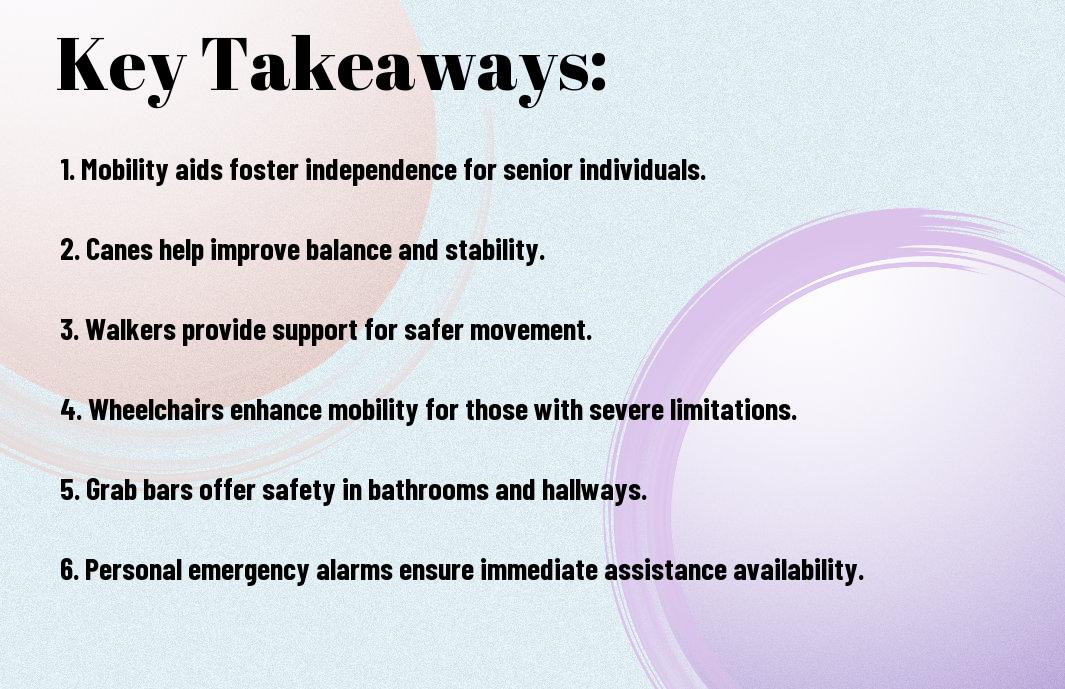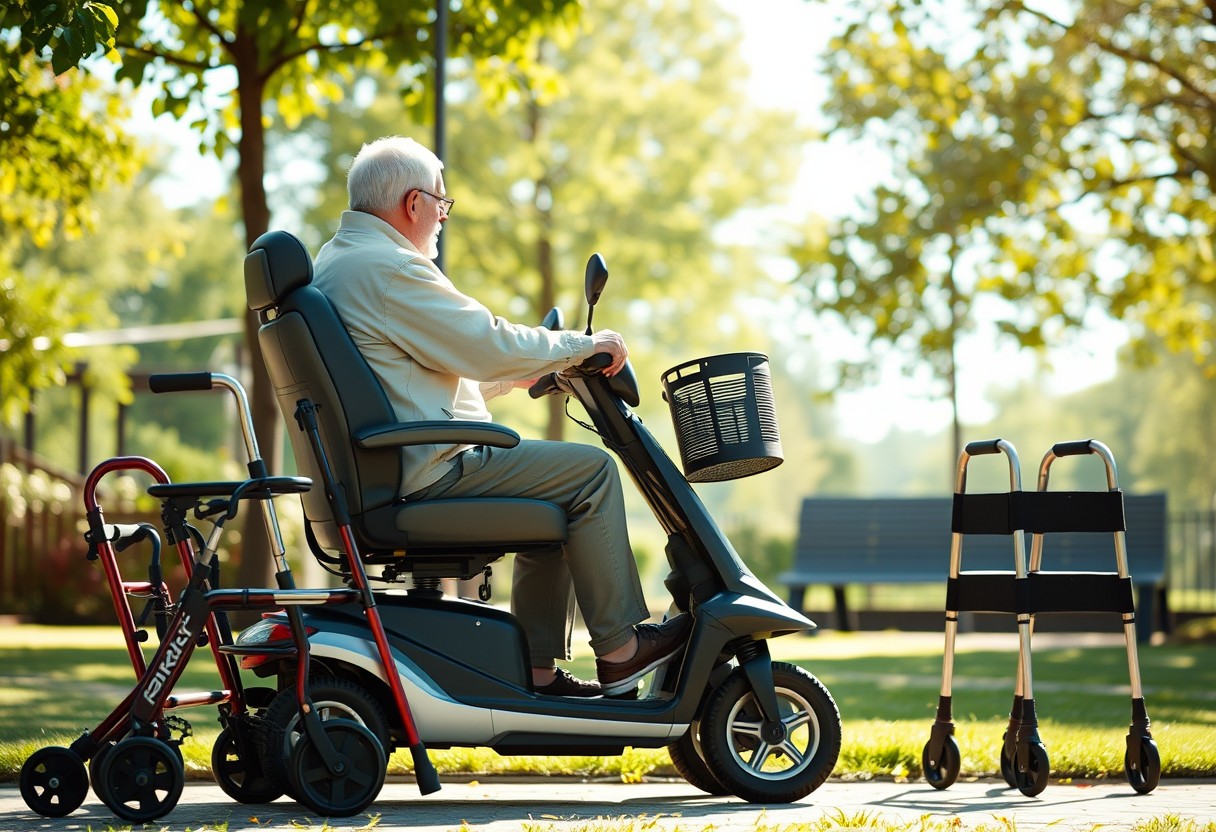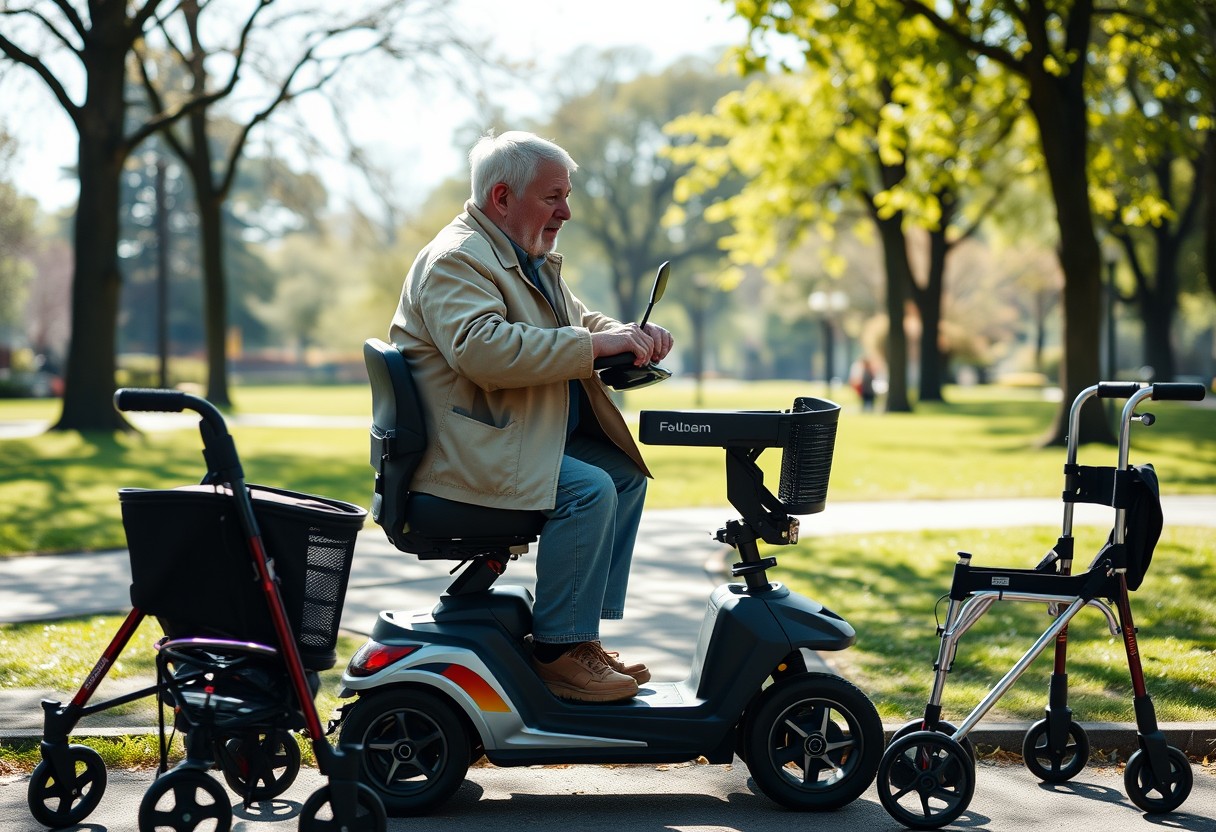There’s a growing recognition of the importance of mobility aids in enhancing the quality of life for seniors. As individuals age, their independence may decline due to mobility challenges, making it crucial that they have access to the right tools. Mobility aids not only promote safe movement but also significantly improve their overall well-being. Whether it’s a sturdy walker, a customizable cane, or even a wheelchair, these devices empower seniors to maintain their autonomy and engage actively in their daily lives. Understanding these aids can help families make informed decisions that cater to their loved ones’ needs.
Key Takeaways:
- Mobility Aids play a crucial role in enhancing the independence of seniors, allowing them to maintain mobility and engage in daily activities with greater ease.
- Types of Aids include walkers, wheelchairs, and scooters, each designed to cater to specific mobility needs and ensure comfort and safety.
- Personalized Solutions are vital; selecting the right mobility aid depends on individual health conditions, lifestyle, and personal preferences to maximize independence.

Understanding Mobility Challenges
For many seniors, mobility challenges can significantly hinder their daily activities, leading to increased dependence on others. As physical abilities decline due to age or health issues, simple tasks such as walking, standing, or climbing stairs can become arduous and frustrating. It is crucial for caregivers and family members to recognize these challenges to provide the necessary support and resources that enable seniors to maintain their autonomy and quality of life.
Common Mobility Issues in Seniors
Understanding the various mobility issues that seniors face is vital for promoting effective solutions. Common challenges include arthritis, which can cause joint pain and stiffness; balance problems, increasing the risk of falls; and weakened muscles, which can diminish overall strength and coordination. These conditions often result in reduced mobility and can create barriers to participating in social activities and maintaining an active lifestyle.
The Impact of Mobility on Independence
Any limitation in mobility can have a profound effect on a senior’s sense of independence and quality of life. As their ability to move independently decreases, they may find themselves relying on caregivers or adapting to a more sedentary lifestyle. This change can lead to feelings of frustration, helplessness, and isolation, further exacerbating mental health issues such as depression or anxiety.
Impact of mobility on independence cannot be understated. When he or she experiences reduced mobility, it often leads to a decreased sense of control over their daily lives. The inability to perform routine tasks independently can have a cascading effect, fostering feelings of isolation and altering their social interactions. Conversely, improving mobility through the use of aids can enhance their self-esteem, leading to a more active lifestyle and fostering connections with family and friends. Overall, it is vital to address these mobility challenges to empower seniors to reclaim their independence and enjoy fulfilling lives.
Types of Mobility Aids
Some of the imperative types of mobility aids that enhance independence for seniors include:
- Walkers
- Rollators
- Canes
- Crutches
- Wheelchairs
The Promoting Independence and Well-being for Seniors initiative highlights the importance of these tools in maintaining a senior’s mobility.
| Mobility Aid | Description |
| Walkers | Provide stability and support while walking. |
| Rollators | Feature wheels for easier navigation. |
| Canes | Offer assistance and balance. |
| Crutches | Help with mobility post-injury or surgery. |
| Wheelchairs | Assist those with limited mobility. |
Walkers and Rollators
An effective solution for seniors facing mobility challenges is the use of walkers and rollators. Walkers provide a stable frame for support, while rollators come equipped with wheels and a seat, allowing individuals to rest as needed. Both options are designed to give users increased independence in their day-to-day activities.
Canes and Crutches
Canes are versatile mobility aids that help individuals maintain balance and stability while walking. Crutches, on the other hand, are specifically designed for those recovering from injuries. Together, these aids provide crucial support for those who need it.
Mobility aids like canes and crutches are imperative in assisting individuals to bear weight and move safely. They not only offer physical support but also contribute significantly to a person’s confidence. With the right choice, he or she can regain the ability to navigate their surroundings and partake in activities they enjoy.
Wheelchairs and Scooters
Any senior facing severe mobility restrictions can benefit from wheelchairs and scooters. These aids enable individuals to travel longer distances with minimal exertion. Wheelchairs can be manual or powered, while scooters offer the convenience of outdoor mobility.
Another significant aspect of using wheelchairs and scooters is their ability to improve a senior’s quality of life. With special features such as adjustable seating and enhanced maneuverability, these devices promote independence and foster social interactions, allowing them to engage more with their community.

Choosing the Right Mobility Aid
Keep in mind that selecting the appropriate mobility aid is vital for enhancing a senior’s independence. A thorough understanding of their unique needs, preferences, and health conditions is important for making an informed decision. The right mobility device not only supports physical mobility but also boosts confidence and encourages an active lifestyle.
Assessment of Individual Needs
Choosing the right mobility aid begins with assessing an individual’s specific needs. This assessment should consider factors such as their physical abilities, daily activities, and environmental challenges they may face. Personal preferences, including style and ease of use, also play a significant role in ensuring that the mobility aid chosen fits seamlessly into her daily routine.
Consulting Healthcare Professionals
An important step in the decision-making process is consulting healthcare professionals. Their expertise can guide families in determining the most suitable mobility aids that match the senior’s health conditions and lifestyle.
For instance, physical therapists may assess strength and balance, suggesting devices like canes or walkers, while doctors can evaluate medical conditions that might necessitate stronger solutions such as wheelchairs. Engaging with a healthcare professional ensures that the right mobility aid not only meets functional needs but also addresses safety concerns, reducing the risk of falls or injury. Ultimately, this collaboration leads to better outcomes and promotes a greater sense of independence for seniors.
Benefits of Using Mobility Aids
Once again, it is important to recognize that mobility aids are designed not just to assist, but also to empower seniors. These tools help him or her maintain independence, enhance overall quality of life, and encourage participation in daily activities. By using mobility aids, they can navigate their environment with confidence, ultimately leading to a more active and fulfilling lifestyle.
Enhancing Safety and Reducing Fall Risk
Benefits of incorporating mobility aids into daily routines are numerous. They provide critical support that minimizes the chances of accidents, enabling him or her to move around safely in their living spaces. With features like non-slip grips and sturdy construction, these aids can significantly reduce the risk of falls, promoting safety and stability.
Encouraging Social Engagement
On the other hand, mobility aids not only promote physical safety but also facilitate social interactions. When seniors have access to these devices, they are more likely to venture out for social activities, whether it’s visiting friends or engaging in community events.
Risk of isolation looms large for seniors who struggle with mobility, as they may feel hesitant to participate in social gatherings. By using mobility aids, they can reclaim their independence and overcome barriers to outreach. These aids help them feel more secure and confident, allowing for meaningful connections with others. The opportunity to engage in community activities not only lifts their spirits but also fosters a sense of belonging, ultimately enhancing their overall mental and emotional well-being.
Maintenance and Care for Mobility Aids
Now that he has equipped himself with the right mobility aids, understanding their maintenance and care is crucial for ensuring continued independence. Regular inspection and proper care can extend the lifespan of these devices while simultaneously enhancing safety. For more insights into how assistive devices can boost Independence and Safety Assistive Devices for Seniors, readers can explore several resources.
Regular Inspections and Repairs
Maintenance of mobility aids involves regular inspections to identify any potential issues. He should ensure that moving parts function smoothly and that there are no signs of wear and tear. He can check:
- Wheels for jams or damage.
- Handgrips for tears or loosening.
- Brakes for responsiveness and integrity.
Regularly addressing these points can prevent mishaps and ensure that he remains safe while using his mobility aids.
Cleaning and Storage Tips
Cleaning mobility aids not only enhances their appearance but also ensures they operate correctly. Regular cleaning should focus on removing dirt and grime, while proper storage will help maintain their functionality. Guidelines include:
- Using mild soaps and warm water to clean surfaces.
- Avoiding harsh chemicals that may damage materials.
- Storing aids in a dry place when not in use.
After ensuring cleanliness, he should also consider safety in storage locations to prevent accidents.
Plus, keeping mobility aids clean presents many benefits, such as:
- Minimizing grime buildup that could affect functionality.
- Extending the life of mobility devices.
- Making a positive impression when they are used in public spaces.
After addressing these cleaning and storage tips, he can enjoy the user experience while maintaining their reliability.
Resources and Support for Seniors
Your journey towards enhanced independence is supported by a wealth of resources available for seniors. They can explore various programs and organizations that cater to both mobility needs and social engagement. For an insightful overview, check out the Top 5 Essential Mobility Aids for Seniors – Enhance Independence … that detail how specific aids can promote a more active lifestyle.
Community Programs and Services
Any senior looking to improve their quality of life should consider engaging with local community programs and services. Many organizations offer classes, support groups, and social activities designed to foster a sense of belonging and provide practical assistance with mobility challenges.
Financial Assistance Options
One way to ease financial concerns is by exploring the various financial assistance options available for seniors. Many local and federal programs exist to help cover the costs of mobility aids, home modifications, and transportation services.
Understanding the landscape of financial assistance options is crucial for seniors seeking independence. Many programs can provide substantial financial support for mobility aids and vitals. It’s vital for them to research grants, subsidies, and low-interest loans that are specifically tailored for seniors. Additionally, community organizations often offer resources and guidance to navigate applications. Ensuring they stay informed about these options can lead to improved financial security and greater independence.
Final Words
Conclusively, empowering seniors with vital mobility aids is crucial in enhancing their independence and quality of life. By utilizing devices such as walkers, canes, and wheelchairs, they can navigate their environments safely and confidently. These aids not only provide physical support but also promote emotional well-being by allowing them to engage in daily activities and maintain social connections. As she or he embraces these tools, they regain a sense of autonomy, illustrating the profound impact mobility aids can have on his or her overall health and happiness.
FAQ
Q: What are the important mobility aids for seniors?
A: Essential mobility aids for seniors include walking canes, walkers, rollators, wheelchairs, and scooters. Each of these aids serves a unique purpose: walking canes provide stability and support, walkers enhance balance and safety, rollators offer a combination of a walker with wheels and a seat, wheelchairs allow for easier transport and independence, and scooters provide mobility for those who may have difficulty walking long distances. Choosing the right mobility aid depends on the individual’s specific needs and level of mobility.
Q: How do mobility aids enhance independence for seniors?
A: Mobility aids enhance independence for seniors by providing the support and confidence needed to move around safely and effectively. With the right aid, seniors can perform daily activities such as shopping, visiting friends, or enjoying outdoor spaces without relying heavily on caregivers. The ability to move independently can significantly boost their self-esteem and mental well-being. Furthermore, mobility aids can help prevent falls, which is crucial for maintaining safety and independence in older adults.
Q: What factors should seniors consider when choosing a mobility aid?
A: When choosing a mobility aid, seniors should consider several factors including their level of mobility, the environments where the aid will be used (such as indoors or outdoors), their physical strength, and personal preferences. It’s important to assess the size and weight of the aid, as maneuverability is key. Additionally, consulting with a healthcare professional can help identify the most suitable mobility aid based on individual health conditions and capabilities. Comfort, ease of use, and adjustability are also important factors to ensure the chosen aid meets their needs effectively.

